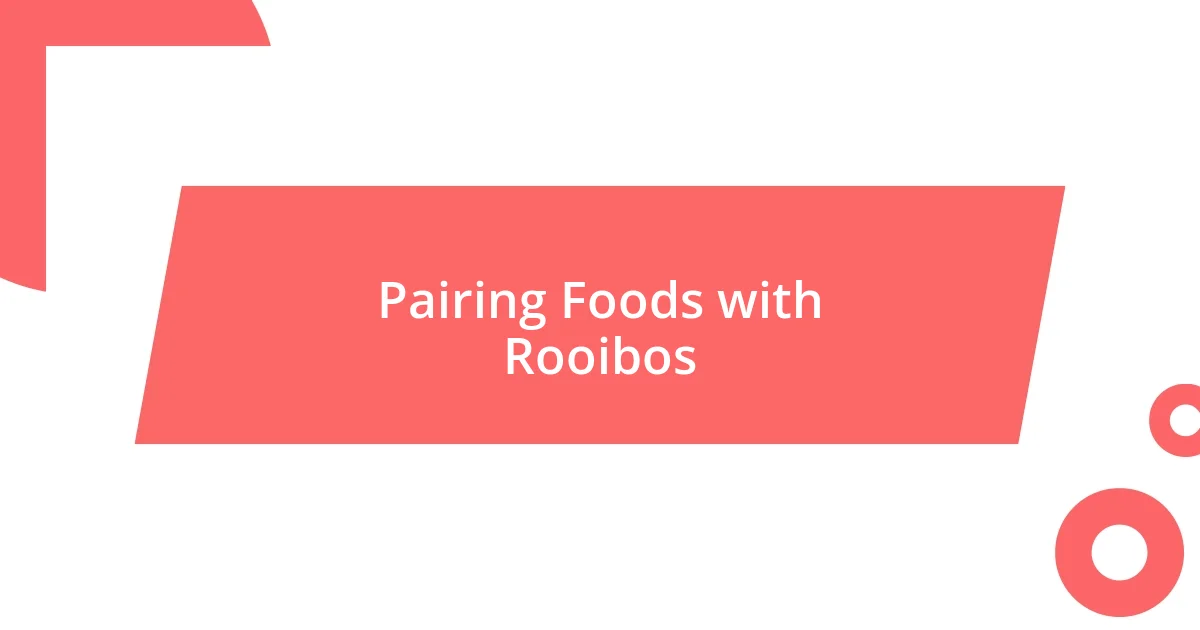Key takeaways:
- Rooibos tea is caffeine-free and rich in antioxidants, offering potential health benefits such as improved heart health and essential mineral content.
- It serves as a versatile cooking ingredient, enhancing both savory and sweet dishes, while adding depth of flavor when used as a liquid base or incorporated into dry ingredients.
- Experimentation with rooibos in cooking, such as in salads or desserts, can elevate ordinary meals and create unique culinary experiences.

Introduction to Rooibos Tea
Rooibos tea, with its deep red hue and naturally sweet flavor, captures my heart every time I brew a cup. Grown exclusively in the Cederberg region of South Africa, this herbal infusion has a rich cultural heritage that resonates with me. Have you ever considered how a simple cup of tea can connect you to a distant part of the world?
What fascinates me about rooibos is its caffeine-free nature, making it a soothing option for any time of day. I often find myself sipping it in the late afternoon; it’s like a gentle hug in a cup. The earthy, slightly nutty notes remind me of a cozy fireplace, inviting relaxation after a long day. Have you felt that comforting warmth radiate from your favorite drink?
Rooibos is not just delicious; it’s packed with antioxidants, too. I still remember the first time I learned about its health benefits—my eyes widened with curiosity. Isn’t it amazing how something so tasty can also contribute to our wellness? I always feel a bit more content knowing that my love for this beverage is also nurturing my body.

Health Benefits of Rooibos
Rooibos tea is rich in antioxidants such as aspalathin and nothofagin, which can play a crucial role in combating oxidative stress in the body. When I first learned about antioxidants, I was struck by how they help protect our cells from damage. It’s like having a personal squad of defenders working tirelessly for my well-being; I can’t help but smile when I think about it.
What really captured my attention is rooibos’ potential benefits for heart health. Studies suggest that it may help lower blood pressure and improve cholesterol levels. I remember the moment I switched to rooibos after having a wrenching palpitation incident; I felt hopeful knowing I was choosing something that could support my heart.
Additionally, rooibos contains minerals like calcium, magnesium, and zinc, which are essential for my overall health. I recall discussing with a friend how I started drinking rooibos after long runs to aid in my recovery. Those minerals feel like my body’s best friends, helping me bounce back after a tough workout!
| Health Benefit | Description |
|---|---|
| Antioxidant Properties | Rich in aspalathin and nothofagin, protecting cells from oxidative damage. |
| Heart Health | May help lower blood pressure and improve cholesterol levels. |
| Mineral Content | Contains calcium, magnesium, and zinc, aiding overall health and recovery. |

Choosing Rooibos for Cooking
When it comes to choosing rooibos for cooking, I find it to be an exceptional ingredient that elevates both flavor and health. The naturally sweet and robust profile of rooibos effortlessly complements a variety of dishes—from savory to sweet. I remember the excitement I felt the first time I incorporated it into a creamy risotto. The warm and earthy notes added a lovely depth that left my taste buds dancing.
Here are a few key points to consider when selecting rooibos for your culinary adventures:
- Quality Matters: Opt for loose-leaf or high-quality rooibos tea bags to ensure a rich flavor. I always feel that the fresher the tea, the more vibrant the taste.
- Caffeine-Free Versatility: Its lack of caffeine makes it a perfect addition to both day and night dishes, allowing endless creativity in the kitchen.
- Flavor Pairings: Rooibos pairs beautifully with spices like cinnamon and cardamom. I once added it to a spiced cake recipe, and the result was divine—satisfying both my palate and my soul.
- Liquid Base: Consider using brewed rooibos as a base for soups or stews to enhance their flavor profile. When I made a hearty vegetable soup with rooibos, it felt like a warm hug in a bowl.
Experimenting with rooibos has truly opened up new culinary pathways for me. With each dish, I find it brings not just flavor but also a sense of connection to my heritage and the wider culinary world.

Preparing a Rooibos Infused Dish
When preparing a rooibos-infused dish, the first step I recommend is to brew a strong cup of rooibos tea. I remember the first time I made rooibos risotto; I brewed it longer than usual, letting the flavors really develop. The vibrant, earthy essence that emerged was nothing short of enchanting, and I found myself imagining the endless possibilities.
For the dish itself, you can substitute brewed rooibos for whatever liquid your recipe calls for, be it broth, water, or even milk. This little twist can transform the entire flavor profile! I often think back to a dinner party where I used rooibos instead of vegetable broth in my lentil stew. The guests were curious about the intriguing taste, and it sparked a lively conversation about unconventional ingredients.
Lastly, don’t shy away from adding rooibos directly into your dry ingredients. I’ve tried incorporating it into spice blends and baked goods, and the results are often surprisingly delightful! The first time I added ground rooibos to a cookie mix, I was skeptical, but the subtle sweetness and unique flavor turned out to be a game-changer. It made me wonder, what other flavors might be hiding in my pantry, waiting to be discovered?

Recipes for Rooibos-infused Meals
When it comes to cooking with rooibos, one of my favorite recipes is rooibos-infused quinoa salad. I remember one warm summer evening when I decided to experiment by brewing rooibos and using it to cook the quinoa instead of water. The nutty flavor of the quinoa combined with the tea’s naturally sweet notes created a delightful dish that felt refreshing and nourishing. Isn’t it amazing how a simple swap can elevate a mundane salad into something special?
Another delightful dish I’ve tried is rooibos-spiced roasted vegetables. Picture this: I tossed root vegetables in olive oil, a hint of maple syrup, and a pinch of ground rooibos before roasting them. The sweet, earthy undertones of the rooibos paired beautifully with the caramelized sweetness of the veggies. Every bite took me back to that cozy kitchen where the aroma filled the air—it’s like the flavors were dancing together in perfect harmony. How often do we overlook the power of spices to transform our meals, right?
If you’re in the mood for something sweet, I highly recommend making rooibos-infused chocolate brownies. The rich chocolate flavor combined with the subtle, fragrant hints of rooibos created a dessert that felt both indulgent and unique. I vividly recall the joy of serving these at a family gathering; the moment the first bite melted in my mouth—a warm smile spread across my face. It’s these little moments, created with a touch of creativity in the kitchen, that truly enhance our culinary experiences, don’t you think?

Pairing Foods with Rooibos
Pairing foods with rooibos can open up a new world of flavors. One evening, I paired a robust rooibos with grilled chicken marinated in citrus and garlic. The smoky notes of the chicken were beautifully complemented by the tea’s natural sweetness, creating a dish that felt sophisticated yet comfortingly familiar. It made me think: isn’t it fascinating how certain ingredients can elevate a simple meal?
I’ve also had success pairing rooibos with rich dishes like creamy pasta. Recently, I experimented by incorporating rooibos into a cheese sauce. The result was a creamy indulgence with a subtle, aromatic layer that surprised and delighted my taste buds. An unexpected twist like this can create truly memorable dining experiences. How often do we give ourselves permission to be adventurous in the kitchen?
Moreover, I find that rooibos works wonders in enhancing desserts, especially with fruit-based options. On a particularly cozy afternoon, I made a rooibos-infused apple crumble. The tea added warmth that perfectly harmonized with the spices and sweetness of the apples. It was a comforting reminder that food, much like life, is all about the delicate balance of flavors—sometimes, a little experimentation leads to the sweetest outcomes.

Tips for Cooking with Rooibos
When cooking with rooibos, I find that steeping the tea before using it in your dishes can really amplify the flavor. For instance, I learned this when I tried brewing a stronger infusion for my rooibos-infused rice. The aroma filled my kitchen, and the rice came out with this delightful depth that was simply irresistible. Have you ever thought about how a simple step can make such a significant impact?
Another tip I swear by is to balance the sweetness of rooibos with savory elements in your meals. I once created a rooibos-infused vinaigrette for a salad. The combination of the tea’s natural sweetness with vinegar and a touch of mustard transformed the dressing into something spectacular. Each bite sparked a little joy—like finding that perfect balance in a song, where every note complements the others. Isn’t it incredible how a few ingredients can come together to create such a delightful harmony?
Lastly, don’t hesitate to experiment with different cooking methods. I remember making a rooibos-braised beef for a special dinner, allowing the meat to soak up the flavors over a couple of hours. The result was fork-tender beef that was bursting with the warm, earthy notes of rooibos. It struck me then how cooking can be such a personal journey. How often do we get to explore new techniques and find joy in the process?















